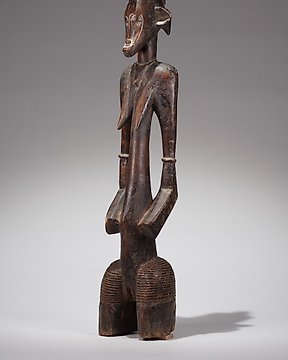
Senufo - Costa do Marfim (Sem preço de reserva)
N.º 82984807

N.º 82984807

An outstanding female Senufo Rhythm pounder, called Déblé, Northern Ivory Coast, village Nafou - uprising from a cylindrical, oval, base with straight, shortened legs, the openwork arms carved beside a slender body with a small pointed navel, the columnar neck supporting a zoomorphic head with a protruding lower jaw, wearing a domed, single crested coiffure, scarification patterns at the body and around the navel, arms, neck and hip with reddish passions pearls on blackened latex; aged patina, the neck, the arms and the base of the statue with significant signs of use, the sculpture is still in the original condition like it was collected in situ. Authentic restoration at the cylindrical base of the sculpture. Normally the traces of use are washed off as soon as these objects arrive on the Western market.
Certain stylistic similarity (penultimate photo) to the Senufo Pounder (90,5 cm) of the Musée Fabre, France/ Museum Cleveland, Ohio, USA, which has softer and less antagonistic forms, It comes from the same region. Certificate of origin and provenance.
Source: Susan Elisabeth Gagliardi,Cleveland Museum, Ohio, USA.Senufo Unbound, pate 46/47 (mostly wellknown is the "Western Provenance" , in the description we read "unknown artist". Perhaps one could say that this is a postcolonial, Western view of Africa, because the makers of these sculptures do not see themselves as "artists" in Africa. They are craftsmen, often blacksmiths, who, despite being integrated into village communities, usually live on the outskirts of the villages. Learning where these villages are and how the carvers influenced each other might say more about Africa than a "family tree" of Western owners. But that would mean that anthropologists do field research in Africa instead of running museums that are under the influence of the art trade.
Lit.: A lecture of Dr. Junker, "der Originalzustand.. Wo ist er geblieben?" Gottschalk Burkhard, "Senufo, Massa und die Statuen des poro" 2002: 43; Glaze Anita J., "Art and Death in a Senufo Village", Indiana University Press, Bloomington 1981. A related eyemplare: Robert Goldwater, Senufo Sculpture from West Africa, New York, 1964, ills. 88 and 88a, Werner Gillon, Collecting African Art, London, 1979, p. 50, fig. 38 William Rubin, "Primitivism" in 20th Century Art: Affinity of the Tribal and the Modern, New York, 1984, vol. 1, p. 131 William Rubin, Le Primitivisme dans l’art du 20e siècle. Les artistes modernes devant l’art tribal, Paris, 1987, p. 131 Jacques Kerchache, Jean-Louis Paudrat and Lucien Stéphan, L'art africain, Paris, 1988, p. 82, pl. 34, Jacques Kerchache, Jean-Louis Paudrat, and Lucien Stéphan (eds.), Die Kunst des Schwarzen Afrika, Freiburg, 1989, p. 80, pl. 34 Jacques Kerchache, Jean-Louis Paudrat and Lucien Stéphan, Art of Africa, New York, 1993, p. 82, pl. 34 Mary H. Nooter, Secrecy: African Art that Conceals and Reveals, New York, 1993, p. 155, cat. 79.
According to Gottschalk, who tried to make a typolgy of the Senufo Déblé, these exemplares would probably be submitted to the group of the kulibèlè and not the fonombèlè.
"Während die ersteren (fonombèlè) entweder wegen mangelnder Fähigkeit zu feinerer Arbeit (the fonombèlè are the blacksmiths in the Senufo society) oder als bewußt eingesetztes Stilmittel die klaren und wuchtigen Formen, die kontrastierenden Waagerechten und Senkrechten weitgehend so beließen, wie sie bei der Festlegung der Proportionen entstanden waren, bemühten sich die kulibèlè (the traditional carver) um ein weiches Ineinanderfließen der Körperteile, soweit sie nicht den Stil ihrer älteren Brüder in ihre Arbeit aufnahmen oder ihn mehr oder weniger kopierten." Source: Burkhard Gottschalk
More realistic sounds the opinion of Glaze, who described the difficulties of a stylistic typology according to both ethnic groups after she did fieldwork around kufulo (region of Dikodougou). Anita J. Glaze, 81.
A Rhythmpounder from the same region, also collected in theNafou region, which we sold three years ago (last photo sequence).
Como comprar na Catawiki
1. Descubra algo especial
2. Faça a licitação vencedora
3. Faça um pagamento seguro